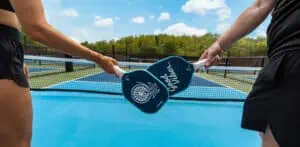Pickleball
Singles vs. Doubles Pickleball: Key Differences in Gameplay and Strategy

When it comes to pickleball, the debate between singles and doubles formats can be as heated as a match point. Have you ever wondered which style better aligns with your interests? Singles pickleball showcases individual talent, where players blaze trails across the court alone, maximizing their skills and strategy. Meanwhile, doubles offers a different kind of thrill—it’s about teamwork and creating a seamless flow between partners. Both formats provide unique experiences that cater to diverse preferences, whether you’re seeking an independent challenge or the camaraderie of playing alongside a friend. Join us as we dive into the key differences in gameplay and strategy between these two exciting styles of pickleball!
The key differences between singles and doubles pickleball lie in court coverage and gameplay strategy. In singles, each player must cover the entire court, leading to a more intense and faster-paced game, while doubles allows players to share responsibilities, promoting teamwork and communication, resulting in longer rallies that emphasize strategic placement of shots.
Singles vs. Doubles Pickleball: The Basics
In singles pickleball, each player takes on the entire court, showcasing individual skills and demanding a high level of stamina and agility. Maintaining excellent footwork is crucial since every inch of the designated 20×44-foot space must be covered. This intense format requires consistent exertion—there’s no teammate to rely on for backup when your opponent strikes a solid shot. It encourages personal growth and strategy development while allowing players to refine their serves and returns in isolation.
With singles gameplay, each point becomes a test of endurance and skill where strategies can pivot between aggressive shots for quick points and defensive plays that involve waiting for your opponent’s mistake.
Conversely, doubles pickleball introduces a delightful social element that many players find appealing. Each side has two players who work in tandem to navigate the court. This shared responsibility lessens physical demands—it’s about strategic positioning and effective communication. The dynamics shift significantly; teamwork becomes essential as partners coordinate plays, taking turns at different positions like net aggression or baseline defense.
As a testament to its popularity, approximately 60% of players prefer the doubles format for its collaborative nature, often leading to longer rallies and a more relaxed atmosphere, making it ideal for both casual players and competitive enthusiasts alike.
Grasping these fundamental differences opens the door to understanding how strategy varies in each format and how these shifts influence your style of play. Now, let’s explore how the layout of the court and player positions are integral to mastering both formats.
Court Layout and Player Positions
The standard pickleball court measures 20 feet in width and 44 feet in length for both singles and doubles play. While the dimensions remain constant, how players occupy that space reflects a world of difference depending on their chosen format.
In singles, the player is responsible for defending the entirety of their half, which encompasses a significant area requiring quick footwork and strategic thinking. Each movement becomes essential; players must dart across the court, demonstrating not just speed but endurance. This coverage leads to a game that can feel intensely fast-paced, as every swing of the paddle propels both strategy and sweat.
Court Coverage in Singles
When engaging in singles gameplay, every inch matters. The sole player on each side has to be vigilant—covering deep corners, anticipating angles, and being aware of potential plays at every moment. This intense responsibility emphasizes stamina and agility; players need to maintain not just their physical energy but also their mental acumen.
The need for lateral movements becomes apparent; they have to push off their back foot swiftly to reach wide shots or sprint forward for volleys. It’s a dance of precision where your footwork can spell victory or defeat.
Court Coverage in Doubles
In contrast, double shifts change the dynamic significantly. With four players on the court, each partner shares responsibilities, often leading to longer rallies with less intensity for individual endurance. Here, positioning takes center stage: one player advances to dominate the net while their partner remains near the baseline. The synergy formed by teammates allows them to execute plays that are almost choreographed—communicating effectively about who covers what area ensures optimal court management.
For instance, when facing an aggressive serve, one player might take charge up front while the other readies at the back—a formation allowing them to maintain control and pressure without exhausting anyone’s individual stamina.
Effective communication during doubles isn’t just beneficial; it’s essential.
When players engage meaningfully, sharing insights through calls and signals enhances their effectiveness immensely. The ability to anticipate each other’s moves turns partners into a formidable unit capable of outmaneuvering opponents with strategic placements rather than sheer force alone.
As we transition into exploring gameplay strategies, understanding these concepts of coverage and positioning will unfold further into tactical advantages that define success in each format of pickleball.
Player Dynamics and Roles
In singles, the player is a one-person show, running the entire court while assuming responsibility for every action—serving, volleying, and defending all fall solely on their shoulders. This dynamic requires not only physical stamina and agility but also a strong mental game. Mistakes can feel amplified because the entirety of the match rides on the individual. Each point lost can weigh heavily, influencing strategy adjustments mid-game and emotional resilience in facing opponents.
Dynamics in Singles
To thrive in singles, players must develop an explosive style characterized by quick footwork and acute awareness of their opponent’s positioning. With no partner to bail them out, the solo player needs to make every shot count. This means selecting shots that aren’t just hard-hitting but strategic—aiming for angles that create openings while simultaneously preparing for a counterattack.
Consider this: consistently winning points means not just focusing on power shots but also honing finesse and control, with around 60% of points often being generated through offensive play. Understanding personal strengths becomes crucial; successful singles players often identify their standout skills early, whether that’s serving accuracy or defensive placement.
Dynamics in Doubles
Moving to doubles, the game transforms into a collaborative effort where partnerships flourish through synergy. Each player takes on distinct roles that maximize their strengths—perhaps one excels at quick net plays while the other capitalizes on powerful baseline rallies. This complementary dynamic fosters effective communication between partners, which is essential for team success.
Jenny, a seasoned player, shares, “My partner and I have developed this bond where I’m agile at the net while he delivers those powerhouse shots from the backline. This balance has tremendously improved our game.” Her experience echoes a key truth: constant verbal and non-verbal communication sweeps through matches like an invisible force. Whether it’s calling out plays or signaling intentions through body language, coordination is not merely advantageous—it can mean the difference between winning and losing.
In doubles, teamwork doesn’t just enhance enjoyment; it significantly influences tactics. Teams employ strategies like controlling the kitchen line to bolster their net game or executing deep serves to keep opponents at bay. Effective communication can increase winning chances by up to 70% compared to teams lacking in this area. Efforts put into cultivating these relationships are essential for elevating overall performance on the court.
As we investigate these player dynamics further, it opens up avenues to explore how specific strategies and techniques can amplify one’s gameplay effectively.
Essential Strategies and Techniques
In the world of pickleball, mastering specific strategies can significantly impact your performance, especially as gameplay dynamics vary between singles and doubles.
Let’s explore the effective techniques that can give you an edge in both formats.
Singles Techniques
In singles play, the focus should be on hitting deep shots and utilizing angles. These tactics not only keep your opponent guessing but also force them to cover more ground, which can wear them out physically. Imagine standing on a wide-open court, each corner presenting opportunities to outmaneuver your opponent.
When you hit deep shots toward the baselines, it stretches their movement and opens up gaps in their defense. This is when you can strike with well-placed drop shots—those subtle touches that catch your opponent off guard and exploit the gaps you’ve created.
Mixing in powerful drives ensures that your opponent remains on their toes, never settling into a rhythm. If all you do is hit soft shots, there’s a chance they’ll take control of the rally. A good rule of thumb is to establish a tempo where both aggressive drives and delicate shots are part of your arsenal.
Doubles Strategies
The strategy shifts when you step onto the court for doubles play, where coordination and communication become paramount:
- Communicate constantly: Maintaining open lines of dialogue with your partner prevents confusion over who is responsible for which shot. Phrases like “Mine!” or “You take it!” can make all the difference during fast exchanges.
- Position yourselves to control the kitchen line: Dominating this critical area boosts your chances of aggressive volleys. When both partners move together toward the kitchen line, it’s an advantageous position for setting up winning shots against opponents trying to pass by.
- Perform synchronized movements: Working together allows players to maintain balance across the court while improving defensive capabilities. If one player moves forward, the other should adapt by covering the backline—creating a safety net that makes it harder for opponents to find openings.
Understanding these strategies enhances personal play and enjoyment during games, as players become more competitive and engaged within their roles. With these techniques in mind, let’s transition to discussing the rules governing how we serve and score in pickleball.
Serving and Scoring Rules
In singles, the server plays a more pivotal role since they alternate sides after each point scored. This means players need to switch between the right and left service boxes depending on their score; an even score means serving from the right side, while an odd score calls for the left. An effective serve is critical because only the serving player can earn points, making it essential for establishing momentum and control in the game. Consider it this way: the serve isn’t just about getting the ball over the net; it’s about positioning your opponent and dictating how they will respond.
Singles Serving Rules
The serve in singles often showcases individual strategies. Fast-paced serves that approach or exceed 50 mph can put significant pressure on opponents. The focus shifts toward precision and placement as players learn to exploit weaknesses rather than merely overpowering their rivals. Quick reflexes and sharp angles become vital as players gauge their opponent’s return capabilities, setting up for successful follow-up shots.
But just when you think you’ve got it down, there’s a whole different dynamic in doubles play that introduces teamwork and strategy into the mix.
Doubles Serving Rules
In doubles, both partners share responsibility for serving, adding an exciting layer of strategy to every match. Each player alternates when serving until they lose a point, meaning that if one partner gets a strong serve in, they have a better chance of creating favorable conditions for their partner’s next shot. Since only the serving duo can score points during their service rotation, deep serves that force back opponents become crucial, creating openings not just for scoring but also to maintain control over the kitchen line—a prime location where aggressive volleys occur.
Think of it like giving your partner room to maneuver; while one player serves deep, the other should be at the ready—positioned strategically at or near the kitchen line to prep for a quick volley should the serve lead to a weak return.
As these nuances unfold, you’ll begin to appreciate how intricately serving styles influence gameplay dynamics and overall strategies on the court.
Game Pace and Player Movement
Singles Game Pace
Singles games are notably faster due to the solo efforts of each player covering the entire court. This dynamic creates an environment where quick reflexes become essential, and stamina is continuously challenged. Imagine the rush as you dash from one corner to the other, relying solely on your speed and agility to respond to your opponent’s shots.
Typically, rallies in singles can average between five and seven shots, pushing players to maintain intensity throughout, often leading to breathless exchanges that require precision and focus. The expansive nature of singles play means that every inch of your court becomes significant; a well-placed shot can drastically shift momentum.
Because every move counts in singles, it’s crucial to implement strategies that maximize efficiency and conserve energy while capitalizing on openings for placing strong shots.
Doubles Player Movement
Conversely, doubles play introduces a collaborative layer that significantly alters pacing and movement dynamics. With two players on each side, court coverage is shared, allowing for longer rallies—often ranging from three to five shots on average as players volley back and forth. This setup reduces the physical toll on each individual while increasing opportunities for strategic positioning and teamwork.
For instance, efficient communication between partners may allow one member to take aggressive positions at the net while the other plays defensively behind them—a tactical approach that makes all the difference during intense exchanges.
As opponents engage in doubles matches, movement tends to be more lateral rather than vertical, giving players the chance to anticipate strategies and work cohesively towards their game plan. Here, controlling the “kitchen line” (the area near the net) becomes paramount; attacking that space can lead to dominant positioning during volleys, where 70% of points are often won in doubles play. Navigating these dynamics adds intricacies that not only test technical skills but also nurture a fulfilling blend of partnership and competition.
With these insights into gameplay pace and movement differences now established, let’s explore how preferences for these formats shape players’ experiences on the court.
Evaluating Singles and Doubles Preferences
When considering your options between singles and doubles, it’s essential to reflect on what you truly enjoy. Doubles provides a dynamic that goes beyond just the game; it fosters social connections and teamwork, making for a richer experience on and off the court.
The shared laughs, strategic discussions during breaks, and even light-hearted banter all contribute to this sense of camaraderie. Many players who thrive on collaboration find that playing doubles not only enhances their skills but also builds friendships as they strategize together to outsmart opponents.
Engagement and Social Interaction
With doubles, the emphasis naturally shifts toward communication with your partner. You learn how to call plays and coordinate movements effectively. It’s a dance of sorts on the court—an elegant interplay between two minds focusing on a singular goal.
For those who value social interactions, this environment makes every match an opportunity to strengthen bonds with fellow players, often resulting in long-term relationships built through shared experiences.
Physical and Mental Challenge
On the flip side, singles draw in players who prefer independence and a personal challenge. If you’re someone who thrives on pushing your limits and honing your own abilities, then singles might be where you feel most at home.
The court becomes your playground; every victory is a testament to your skill and effort alone. This structure appeals particularly to competitive individuals who revel in fast-paced gameplay where every shot requires precision and stamina.
Moreover, the physical demands differ between formats, which can greatly influence preference.
In singles, players cover more ground, frequently experiencing higher exertion levels due to the unique rhythm crafted by solo play. Meanwhile, doubles allow for moments of strategy and rest as partners alternate responsibilities during rallies.
Ultimately, whether you gravitate towards singles or doubles pickleball reflects your personality and play style preferences—an aspect we embrace fully at VibeGetaways.
Our all-inclusive pickleball vacations cater to enthusiasts of both formats by offering specialized courts and coaching sessions tailored to each preference. This balanced approach ensures an unparalleled pickleball experience for everyone involved.
For those eager to explore these options in a vibrant community setting, connect with us today at VibeGetaways or call us at (262) 891-4768. Your ultimate pickleball adventure awaits!
More Articles
Pickleball: The Perfect Family Vacation Activity for Outdoor Fun and Bonding
Looking for a fun way to get the whole family outside and active on your next vacation? Pickleball might be…
Read MorePickleball History and Popularity: From Backyard Roots to a Global Sport
Pickleball started as a simple way for friends and family to have fun together, but today it’s become much more…
Read MoreVacation Planning Tips & Tricks: Your Ultimate Holiday Checklist for 2025
Planning a vacation might seem as simple as booking a flight and packing a bag, but anyone who’s ever felt…
Read More5 Secrets to Stress-Free Vacation Planning: The Ultimate Guide to Easy Travel
Planning a vacation should be exciting, not stressful, but all too often it feels like a juggling act, with flights,…
Read More


